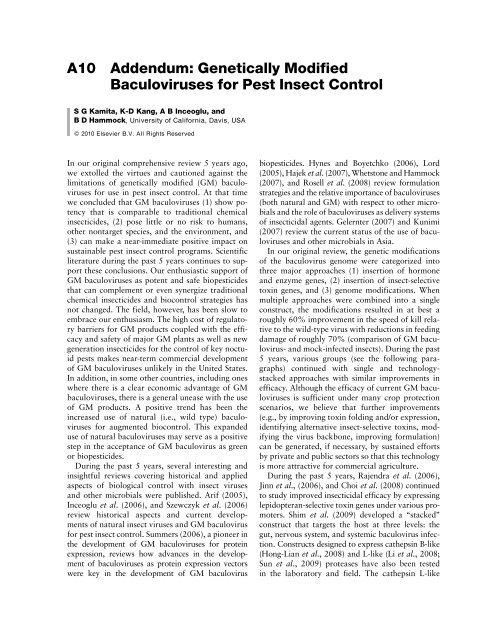Insect Control: Biological and Synthetic Agents - Index of
Insect Control: Biological and Synthetic Agents - Index of
Insect Control: Biological and Synthetic Agents - Index of
You also want an ePaper? Increase the reach of your titles
YUMPU automatically turns print PDFs into web optimized ePapers that Google loves.
A10 Addendum: Genetically Modified<br />
Baculoviruses for Pest <strong>Insect</strong> <strong>Control</strong><br />
S G Kamita, K-D Kang, A B Inceoglu, <strong>and</strong><br />
B D Hammock, University <strong>of</strong> California, Davis, USA<br />
ß 2010 Elsevier B.V. All Rights Reserved<br />
In our original comprehensive review 5 years ago,<br />
we extolled the virtues <strong>and</strong> cautioned against the<br />
limitations <strong>of</strong> genetically modified (GM) baculoviruses<br />
for use in pest insect control. At that time<br />
we concluded that GM baculoviruses (1) show potency<br />
that is comparable to traditional chemical<br />
insecticides, (2) pose little or no risk to humans,<br />
other nontarget species, <strong>and</strong> the environment, <strong>and</strong><br />
(3) can make a near-immediate positive impact on<br />
sustainable pest insect control programs. Scientific<br />
literature during the past 5 years continues to support<br />
these conclusions. Our enthusiastic support <strong>of</strong><br />
GM baculoviruses as potent <strong>and</strong> safe biopesticides<br />
that can complement or even synergize traditional<br />
chemical insecticides <strong>and</strong> biocontrol strategies has<br />
not changed. The field, however, has been slow to<br />
embrace our enthusiasm. The high cost <strong>of</strong> regulatory<br />
barriers for GM products coupled with the efficacy<br />
<strong>and</strong> safety <strong>of</strong> major GM plants as well as new<br />
generation insecticides for the control <strong>of</strong> key noctuid<br />
pests makes near-term commercial development<br />
<strong>of</strong> GM baculoviruses unlikely in the United States.<br />
In addition, in some other countries, including ones<br />
where there is a clear economic advantage <strong>of</strong> GM<br />
baculoviruses, there is a general unease with the use<br />
<strong>of</strong> GM products. A positive trend has been the<br />
increased use <strong>of</strong> natural (i.e., wild type) baculoviruses<br />
for augmented biocontrol. This exp<strong>and</strong>ed<br />
use <strong>of</strong> natural baculoviruses may serve as a positive<br />
step in the acceptance <strong>of</strong> GM baculovirus as green<br />
or biopesticides.<br />
During the past 5 years, several interesting <strong>and</strong><br />
insightful reviews covering historical <strong>and</strong> applied<br />
aspects <strong>of</strong> biological control with insect viruses<br />
<strong>and</strong> other microbials were published. Arif (2005),<br />
Inceoglu et al. (2006), <strong>and</strong> Szewczyk et al. (2006)<br />
review historical aspects <strong>and</strong> current developments<br />
<strong>of</strong> natural insect viruses <strong>and</strong> GM baculovirus<br />
for pest insect control. Summers (2006), a pioneer in<br />
the development <strong>of</strong> GM baculoviruses for protein<br />
expression, reviews how advances in the development<br />
<strong>of</strong> baculoviruses as protein expression vectors<br />
were key in the development <strong>of</strong> GM baculovirus<br />
biopesticides. Hynes <strong>and</strong> Boyetchko (2006), Lord<br />
(2005), Hajek et al. (2007), Whetstone <strong>and</strong> Hammock<br />
(2007), <strong>and</strong> Rosell et al. (2008) review formulation<br />
strategies <strong>and</strong> the relative importance <strong>of</strong> baculoviruses<br />
(both natural <strong>and</strong> GM) with respect to other microbials<br />
<strong>and</strong> the role <strong>of</strong> baculoviruses as delivery systems<br />
<strong>of</strong> insecticidal agents. Gelernter (2007) <strong>and</strong> Kunimi<br />
(2007) review the current status <strong>of</strong> the use <strong>of</strong> baculoviruses<br />
<strong>and</strong> other microbials in Asia.<br />
In our original review, the genetic modifications<br />
<strong>of</strong> the baculovirus genome were categorized into<br />
three major approaches (1) insertion <strong>of</strong> hormone<br />
<strong>and</strong> enzyme genes, (2) insertion <strong>of</strong> insect-selective<br />
toxin genes, <strong>and</strong> (3) genome modifications. When<br />
multiple approaches were combined into a single<br />
construct, the modifications resulted in at best a<br />
roughly 60% improvement in the speed <strong>of</strong> kill relative<br />
to the wild-type virus with reductions in feeding<br />
damage <strong>of</strong> roughly 70% (comparison <strong>of</strong> GM baculovirus-<br />
<strong>and</strong> mock-infected insects). During the past<br />
5 years, various groups (see the following paragraphs)<br />
continued with single <strong>and</strong> technologystacked<br />
approaches with similar improvements in<br />
efficacy. Although the efficacy <strong>of</strong> current GM baculoviruses<br />
is sufficient under many crop protection<br />
scenarios, we believe that further improvements<br />
(e.g., by improving toxin folding <strong>and</strong>/or expression,<br />
identifying alternative insect-selective toxins, modifying<br />
the virus backbone, improving formulation)<br />
can be generated, if necessary, by sustained efforts<br />
by private <strong>and</strong> public sectors so that this technology<br />
is more attractive for commercial agriculture.<br />
During the past 5 years, Rajendra et al. (2006),<br />
Jinn et al., (2006), <strong>and</strong> Choi et al. (2008) continued<br />
to study improved insecticidal efficacy by expressing<br />
lepidopteran-selective toxin genes under various promoters.<br />
Shim et al. (2009) developed a ‘‘stacked’’<br />
construct that targets the host at three levels: the<br />
gut, nervous system, <strong>and</strong> systemic baculovirus infection.<br />
Constructs designed to express cathepsin B-like<br />
(Hong-Lian et al., 2008) <strong>and</strong> L-like (Li et al., 2008;<br />
Sun et al., 2009) proteases have also been tested<br />
in the laboratory <strong>and</strong> field. The cathepsin L-like










